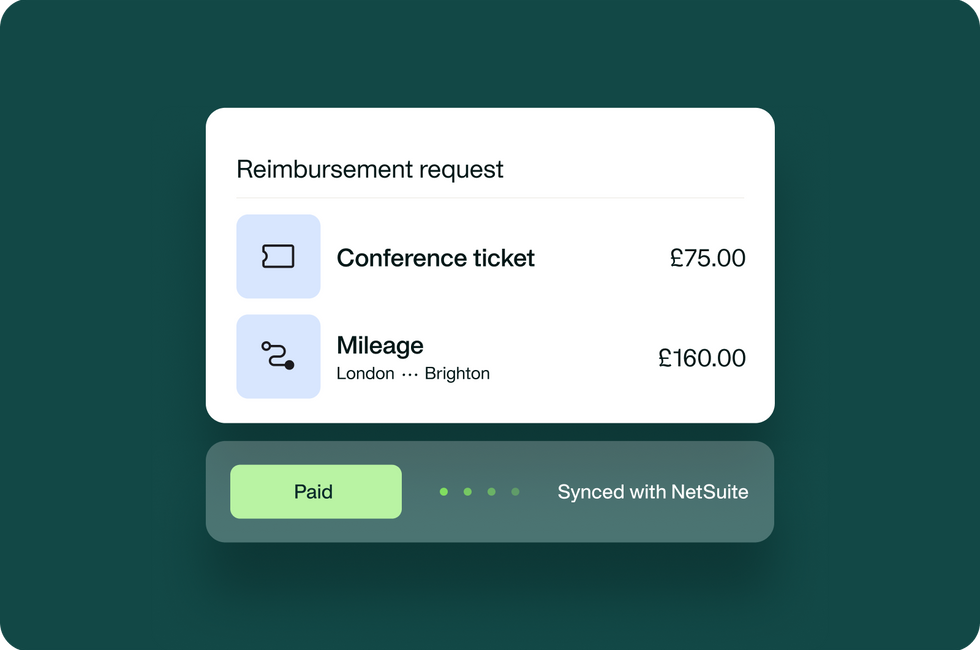
Why employee reimbursements are drowning your company



Managing company expenses and reimbursements is a headache, especially now at the end of the year. But there's a way to streamline your employee reimbursements process and make everyone in your company happy.
By submitting this form, you agree to receive emails about our products and services per our Privacy Policy.
You probably spend more than a couple of hours gathering up and sending your receipts to your accountant every month. Or chasing your employees to send in their missing receipts, maybe even multiple times. Either way, company expenses and reimbursements are one of the many to-dos before closing the financial year. But why are reimbursements so cumbersome, and how can you make this task easier?
Find tips on employee reimbursements and other key business finance topics in our ebook Tips and Tricks to close the year like a pro. The ebook features advice and insights from five expert CFOs and can help make the end of the year run more smoothly.
Credit to the company
In general, most companies have a policy that requires employees to use their personal funds for company expenses, which then get reimbursed. Studies show that more than 40% of employees use out-of-pocket funds for work expenses in the US and UK.
Mandating that employees use personal expenses for work has some pros and cons. Some companies find the concept of no proof, no pay to be a benefit. These companies believe that if employees use their personal cards for work-related expenses, they're more likely to keep the receipts and hand them over to the accounting team. Otherwise, no proof, no pay. Employees can benefit, too, as they have added flexibility and don't have to ask for funds before the expense. They can also get additional miles/points on their credit card.
The drawbacks then: First, highly-skilled and highly-paid professionals have to handle low-level admin work. These professionals will waste hours and hours gathering receipts and sending expense reports, which is financially inefficient and increases employee frustration. Moreover, it can create feelings of unfairness in the employee, as they're essentially giving credit to the company. The result can mean sending employees' morale, productivity, and loyalty down the drain.
The second main drawback is budget clarity. Finance teams have zero visibility of how many reimbursements they will need to incur that month and an imprecise view of cash flow. Third: Expense policies are often outdated and rarely applied, and these can result in tricky conversations with your team. You and your finance team could be meeting to discuss budget planning and cost-saving strategies to optimize the business. When instead, you're fighting over a 15€ breakfast receipt.
Stop chasing receipts: Discover easy, efficient expense management.
Company cards feat’ control and governance
As a fintech company whose main aim is to solve problems for our customers when it comes to payments, expenses, and reporting, we understand the pain points involved in managing reimbursements. We believe company cards are the way forward. But not just any company cards. Cards backed by innovative software that allow for better transparency, governance, and control.
Most finance teams or CFOs are sceptical of this, as freely giving access to company funds can be scary. But, can you imagine if the company cards had in-built spend policies and caps? What about customized workflows for the approval of any new employee fund requests? Well, this is what fintech companies like Payhawk can offer versus your traditional bank card.
Having a totally transparent view of real-time company spend is crucial for everyday business operations. While having real-time data of the company’s cash flow can help finance teams, budget owners, and CFOs make strategic decisions in no time. Plus, with company cards, your employees will be more empowered to spend in ways that optimize the business instead of worrying if their personal funds can cover a purchase.
We know it’s hard to make changes like these, especially in big companies. So, we offer one-click reimbursements in our expense management software for those who are not heavy spenders and might not qualify for a company card.
Reimbursements with Payhawk
For most traditional reimbursements, employees can expect to be reimbursed in the next paycheck, which can be more than 30 days after the expense. This practice is not good. The employee is basically lending the company money during that period.
When we kept hearing that reimbursements were time-consuming for customers, we developed a process that works for both the employee and the finance team. Here's how it looks:
Once your employee makes a payment with their personal card and adds the expense in the mobile app, they'll be asked to input their personal bank account details. Then once the accounting team reviews the expense, your employee can be reimbursed immediately and on the go.
How do we do this? Easy. When you open your account in Payhawk, you have a dedicated IBAN. Meaning your account works like a bank account where you can send funds to your employees, with the reimbursements feature, and pay bills to your suppliers.
Since launching the reimbursements feature a few weeks ago, we've only heard positive feedback from clients. Our customers are saving a lot of wasted time in the process, and they also really like the option to do reimbursements in bulk. Want to test it for yourself? Book a demo to learn more.
An integral part of Payhawk’s journey from the very beginning, Raquel has seamlessly transitioned across key roles—starting in sales, building the customer success team from the ground up, and later moving into content and product marketing. Today, she thrives as a Senior Product Marketing Manager and also leads the company’s ESG efforts. Outside of work, Raquel is passionate about the outdoors and enjoys swimming, hiking, and baking for her two children.
Related Articles


The eight best travel and expense management software solutions

